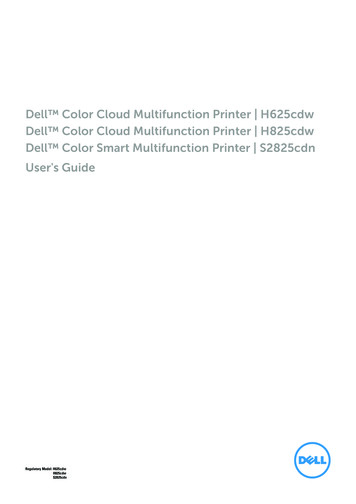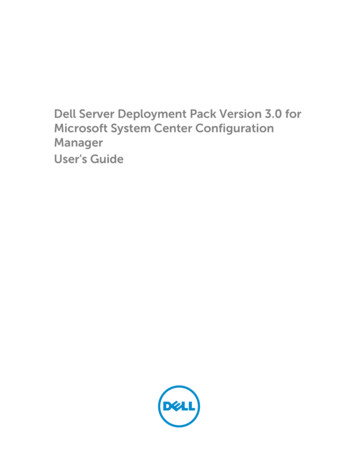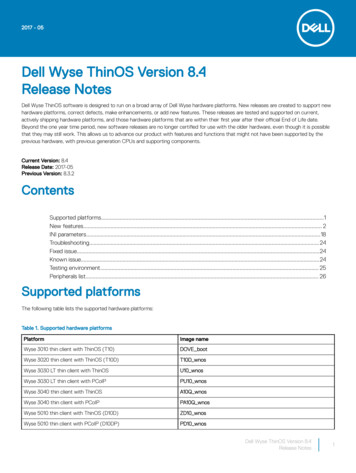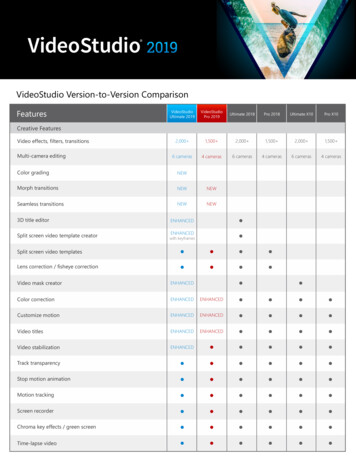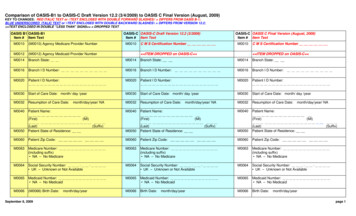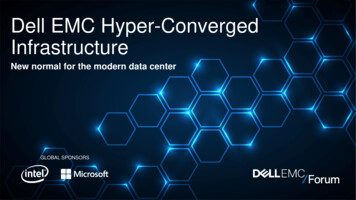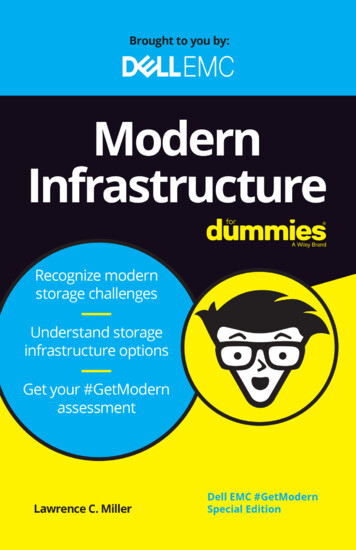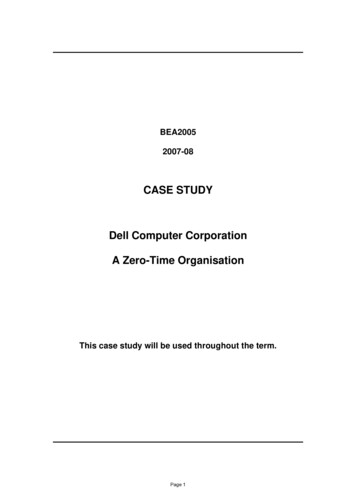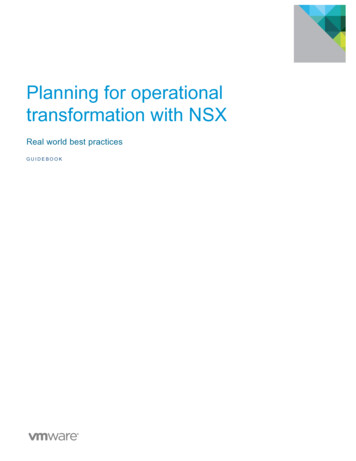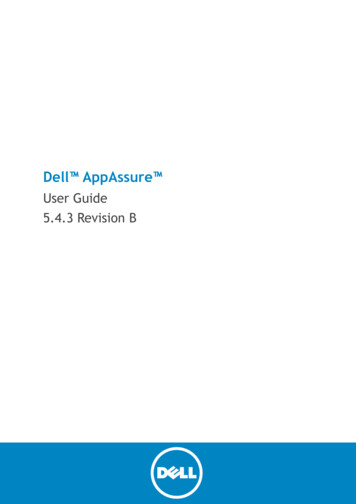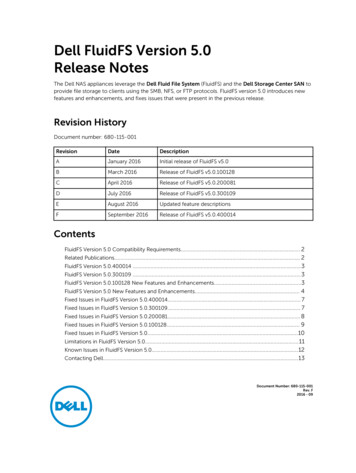
Transcription
Dell FluidFS Version 5.0Release NotesThe Dell NAS appliances leverage the Dell Fluid File System (FluidFS) and the Dell Storage Center SAN toprovide file storage to clients using the SMB, NFS, or FTP protocols. FluidFS version 5.0 introduces newfeatures and enhancements, and fixes issues that were present in the previous release.Revision HistoryDocument number: 680-115-001RevisionDateDescriptionAJanuary 2016Initial release of FluidFS v5.0BMarch 2016Release of FluidFS v5.0.100128CApril 2016Release of FluidFS v5.0.200081DJuly 2016Release of FluidFS v5.0.300109EAugust 2016Updated feature descriptionsFSeptember 2016Release of FluidFS v5.0.400014ContentsFluidFS Version 5.0 Compatibility Requirements. 2Related Publications. 2FluidFS Version 5.0.400014 .3FluidFS Version 5.0.300109 .3FluidFS Version 5.0.100128 New Features and Enhancements.3FluidFS Version 5.0 New Features and Enhancements. 4Fixed Issues in FluidFS Version 5.0.400014. 7Fixed Issues in FluidFS Version 5.0.300109. 7Fixed Issues in FluidFS Version 5.0.200081.8Fixed Issues in FluidFS Version 5.0.100128. 9Fixed Issues in FluidFS Version 5.0.10Limitations in FluidFS Version 5.0.11Known Issues in FluidFS Version 5.0.12Contacting Dell.13Document Number: 680-115-001Rev. F2016 - 09
FluidFS Version 5.0 Compatibility RequirementsMake sure that the following requirements are met prior to using FluidFS version 5.0.Table 1. FluidFS Version 5.0 Compatibility RequirementsComponentRequirementSupported update paths fromprevious versions of FluidFSFor the supported update paths to FluidFS version 5.0, see the DellFluid File System Version 5.0 Support Matrix available from dell.com/support.Storage Center OSUp to eight Storage Centers running version 6.5.x or later.NOTE: Storage Center OS version 6.6.1 or later is required tosupport 4 PB across two or more Storage Centers.Dell Storage ManagerDell Storage Manager 2015 R3.1 or laterNOTE: Dell recommends updating to the latest supported DellStorage Manager version before updating the FluidFS software.Supported platformsFS8600Related PublicationsThe publications listed in the following sections comprise the core Dell FluidFS documentation set. Thesepublications are sorted by target audience.Documents for Dell Customers Dell FluidFS Version 5.0 Administrator’s Guide – Provides information about using the Dell StorageManager software to manage FS appliances, and provides information about FS appliance monitoringand troubleshooting. Dell FluidFS Version 5.0 CLI Reference Guide – Provides information about the FS command-lineinterface. Dell FluidFS Version 5.0 Firmware Update Guide – Provides information about updating the FluidFSsoftware from version 4.0 to 5.0 and from v5.0 service packs. Dell Storage Manager Installation Guide – Provides information about installing and configuring theDell Storage Manager Data Collector and Dell Storage Manager Client. Dell Storage Manager Administrator’s Guide – Describes how to use the Dell Storage Managersoftware to manage Storage Center and FS8600 appliances. Dell Storage Manager Release Notes – Provides information about Dell Storage Manager releases,including new features and enhancements, open issues, and resolved issues.Documents for Dell Installers and Certified Business Partners Dell FluidFS Version 5.0 FS8600 Appliance Pre-Deployment Requirements – Provides a checklist thatassists in preparing to deploy an FS8600 appliance before a Dell installer or certified business partnerarrives onsite to perform an FS8600 appliance installation. Dell FluidFS Version 5.0 FS8600 Appliance Deployment Guide – Provides information aboutdeploying an FS8600 appliance, including cabling the appliance to one or more Storage Centers andthe network, and deploying the appliance using the Dell Storage Manager software.2Dell FluidFS Version 5.0 Release Notes
Dell FS8600 Appliance Service Guide – Provides information about FS8600 appliance hardware,system component replacement, and system troubleshooting. Dell NAS Appliance SFP Replacement Procedure – Provides information about replacing SFP transceivers on an inactive system. Dell FluidFS FS8600 Appliance 1Gb to 10Gb Upgrade Procedure – Provides information aboutupgrading a Fibre Channel FS8600 appliance from 1Gb Ethernet client connectivity to 10Gb Ethernetclient connectivity.FluidFS Version 5.0.400014Version 5.0.400014 contains fixed issues, shown on Page 7.FluidFS Version 5.0.300109Version 5.0.300109 contains fixed issues, shown on Page 7.FluidFS Version 5.0.100128 New Features andEnhancementsVersion 5.0.100128 introduced the following new features and enhancements.Dedicated FluidFS Replay ProfileFor FluidFS deployments, Dell Storage Manager creates a dedicated FluidFS replay that is automaticallyassigned to FluidFS LUNs (volumes on the Storage Center). The profile setting defaults to Daily, and theretention policy is to delete after 25 hours. This feature will take effect only during an initial installation ofFluidFS v5.0.100128. You cannot activate this feature if you are updating the firmware to v5.0.100128.Automatic ACL to UNIX Word 777 MappingWhen files with Windows ACLs are displayed from NFS clients, the FluidFS mapping algorithm shows atranslated UNIX access mode. Perfect translation is not possible, so a heuristic method is used totranslate from the Windows ACL to the 12 bits of the UNIX word. However, when some special SIDs areused inside ACL (for example, creator-owner ACE), the mapping can be inaccurate. For someapplications, NFS clients must see the exact mapping or a mapping for more permissive access.Otherwise, the NFS applications might not perform denied operations.This release adds an option that causes all objects with SMB ACLs to be presented with UNIX Word 777from NFS clients (for display only). This option, which is disabled by default, can be configured under NASVolume settings.NOTE: Actual data-access checks in FluidFS are still made against the original security ACLs.This feature applies only to NAS volumes with Windows or mixed security style (for files with WindowsACLs).Dell FluidFS Version 5.0 Release Notes3
NDMP Exclude Paths and Patterns Using FluidFSConfiguring DMA clients with data-exclusion patterns might not work with some backup vendors such asBackupExec and Netbackup. FluidFS v5.0.100128 adds options for handling exclude paths and patterns,which will be skipped when executing NDMP backup on the NAS volume.This option can be configured at the NAS volume level, and is available under NAS Volume settings.FluidFS Version 5.0 New Features and EnhancementsVersion 5.0.002821 introduces the following features and enhancements. For more information anddetailed instructions about using these features, refer to the Dell FluidFS Version 5.0 FS8600 ApplianceAdministrator’s Guide.Scalability Global namespace – Also referred to as redirection folders, simplifies access to unstructured dataspread across multiple NAS systems by providing a single SMB or NFS mount point for the clients.One or more redirection folders can be created on a FluidFS share and/or export to point clients toother shares and/or exports residing internally or externally to a FluidFS system. In this way, usersneed to know only one location to access their files, which could reside on one or more NAS deviceson the LAN or WAN. By using FluidFS redirection folders, access to tens of petabytes of data can befrom one global namespace for both SMB and NFS clients.NOTE:– Global namespace can be used only if all of the NAS servers support SMBv2 or NFSv4 or later.– Redirection folders are not supported for OSX SMB access, due to lack of support in OSX forwide links.– Redirection folders are not supported in SMBv1 or NFSv3.– NDMP backs up the redirection folder only. It does not back up the data to which the folderis redirecting.– Following wide links (the SMB implementation of redirection folders) is disabled by default onWindows clients, and can be enabled with an AD GPO or locally with the fsutil command.The command fsutil behavior query SymLinkEvaluation will show whether wide links areenabled.Extended Protocol Support File Transfer Protocol (FTP) – FluidFS v5 supports anonymous FTP as a data-access protocol, inaddition to SMB and NFS. The NAS administrator can set the FTP landing directory to a NAS volumedirectory, allowing anonymous access to data for users. Note that in FluidFS v4, FTP was used by NASadministrators only to collect and transfer NAS diagnostics and service-pack files from and to the NASsystem. Microsoft BranchCache – Allows branch cache hosts to cache files and retrieve the file data from theserver only if the hash (that is, the file) has changed. The main benefit of this feature is to enhanceperformance over a slow WAN. The NAS administrator can enable or disable this functionality for eachshare (it is disabled by default).4Dell FluidFS Version 5.0 Release Notes
NOTE:– The feature must be enabled on both sides (server and client).– The feature applies to files of sizes between 64 KB and 256 MB. SMBv2 sparse files – Adds support for SMBv2 sparse files. When sparse file functionality is enabledand the application uses the functionality, the system does not allocate hard disk drive space to a fileexcept in regions where it contains nonzero data. When a write operation is attempted where a largeamount of the data in the buffer is zeros, the zeros are not written to the file. Instead, the file systemcreates an internal list containing the locations of the zeros in the file, and this list is used during allread operations. When a read operation is performed in areas of the file where zeros were located,the file system returns the appropriate number of zeros in the buffer allocated for the read operation.In this way, maintenance of the sparse file is transparent to all processes that access it, and is moreefficient than compression in this case.NOTE:– Sparse files are not supported when using SMBv1.– NDMP does not support sparse files. NDMP backs up and restores files with zeros instead ofconverting them to sparse files. SMBv2 symbolic links – Adds support for SMB symbolic links using the Windows command mklink. Asymbolic link is a special type of file that contains a reference to another file or directory in the formof an absolute or relative path and that affects path-name resolution. Symbolic links operatetransparently for most operations: Programs that read or write to files named by a symbolic linkbehave as if they were operating directly on the target file. The link contains a text string that isautomatically interpreted and followed by the operating system as a path to another file or directory.Local file-system symbolic links are available in NTFS starting with Windows Vista and Windows Server2008, but the symbolic links over SMB are available only with SMBv2.NOTE:– NDMP backs up the link only. It does not back up the data to which the link is redirecting.– Following wide links (the SMB implementation of redirection folders) is disabled by default onWindows clients, and can be enabled with an AD GPO or locally with the fsutil command.The command fsutil behavior query SymLinkEvaluation will show whether the wide links areenabled.Data Protection Third-party auditing software support (includes auditing for SMB and NFS) – When enabled, notifiesthe administrator when both systemwide file-access auditing configuration is enabled and the fileoperation matches any active (enabled) preconfigured file-access notification policy for the volume.Auditing events are generated after permissions check for the file operation and before the actualexecution of the operation.– Quest Change Auditor – Enables auditing of the SMB protocol only, starting with this release. Two-way NDMP backup (Direct NDMP) – Enables directly attaching FC tape to the FC switch used byFluidFS, and not through a DMA server. The backup data is transferred directly across Fibre Channel tothe attached backup target without traveling across the LAN. Only the backup control data travelsacross the LAN from the NDMP client with backup software.NOTE:– iSCSI solutions do not support this feature.– Direct connection to a single controller is not supported. NDMP include/exclude path – Adds the ability to include or exclude certain paths for NDMP backupand restore operations. When you define a backup using DMA, you can select specific directoriesfrom the virtual NAS volume to include in, or exclude from, NDMP backup jobs.Dell FluidFS Version 5.0 Release Notes5
Optimize NAS volume for use as VMware vSphere datastore – When enabled, FluidFS snapshots onNAS volumes containing VMs will take VM snapshots, to ensure the VM is always in a consistent state.Access Control Microsoft group policy support – Group Policy and Group Policy Objects (GPO) are a Microsoftframework and set of protocols integrated into Windows clients and servers. GPOs enable centralmanagement of administrative policies. FluidFS v5 supports the file system security GPO that allowsActive Directory administrators to centrally set DACLs, SACLs, and ownership on specific files anddirectories residing in NAS volumes.NOTE: This feature is supported on NTFS or mixed security style volumes only. Ability to set DACL, SACL, owner of SMB shares from Dell Storage Manager – Administrators canconfigure ACLs and ownership of SMB shares using Dell Storage Manager, without the need to log into the specific share. Prior to FluidFS v5, administrators could control those actions only by accessingthe shares or using MMC. Ability to restrict access to .snapshots folder and “previous versions” – Allows the administrator tolimit user access to snapshots through the .snapshot hidden folder and through the “previous version”operation. This feature is configurable for each NAS volume. Ability to set NTFS-style volumes to ignore UNIX/NFS set permission operations – Sets FluidFS toignore UNIX/NFS metadata modification requests (such as chmod, chown, chgrp). FluidFS will “ignore”these types of operations on NTFS-style NAS volumes, and not return any errors to the NFS client. Set hidden attribute on files with a dot prefix via SMB – Allows the administrator to select whetherdot files should be shown to SMB clients by FluidFS. Configure LDAP port – Allows the administrator to configure and use an LDAP port other than thedefault known port, when configuring LDAP for external User Database use.Improved Manageability and Flexibility Replication throttling – Allows the administrator to control client network bandwidth used byreplication jobs. For example, lowering bandwidth usage during working hours and increasingbandwidth consumption during off-hours. Single-port replication – File replication in FluidFS v5 now uses only a single-port communication forall involved components, in contrast to older FluidFS versions that required the use of several TCPports.NOTE:– The single-port infrastructure supports communication over IPv4 and IPv6 ports.– Either one of the following ports can be configured: 10560, 3260– All other unused ports can be closed after updating to FluidFS v5. PowerShell API – Customer-facing API for controlling day-to-day FluidFS operations. REST API – Customer-facing REST APIs provide the ability to manage FluidFS via URL paths. REST APIuses HTTP requests and responses with the standard GET, PUT, POST, and DELETE methods. Manage local users and groups of FluidFS from MMC – Manages local users and groups using theMicrosoft Management Console (MMC) with the Local Users and Groups snap-in. To gainadministrative access to the cluster, log in to Windows as a member of Domain Admins or as amember of the Administrators group on the cluster. FluidFS VAAI plugin – Allows the NAS administrator to disable or enable VAAI plugin accessibility(enabled by default) for security enhancement. Email notification – The FluidFS email notification feature enables you to set a more granular level ofemail notifications by selecting a specific category or severity. FluidFS users are encouraged to useFluidFS email notification instead of the default Dell Storage Manager email notification.6Dell FluidFS Version 5.0 Release Notes
vApp cloning support using Dell Storage Manager and the CLI – FluidFS v4 had the ability to clonevirtual machines serving as datastores, on a FluidFS NAS volume. FluidFS v5 includes the ability to alsoclone a complete vApp, which is a set of VM machines and their configurations set. NTLM authentication is no longer required – In FluidFS v4, the administrator had the ability to definewhether to use the cluster name or controller name as the NetBIOS server name in the NTLM SSPauthentication context (for compatibility with Active Directory domain controllers with the MS15-027security update installed). FluidFS v5 introduces an automatic detection of the Micosoft patch andautomatic configuration of the appropriate FluidFS behavior.Fixed Issues in FluidFS Version 5.0.400014This following issues were fixed in FluidFS v5.0.400014.Table 2. Fixed Issues in FluidFS Version 5.0.400014AreaDescriptionSystem FunctionalityWhen an excessive number (over 200) of ACLs were used, the systemresponse was slow and sometimes disconnected.NAS Volumes, Shares,and ExportsThe FTP client could not append to files on an SMB share when using aWindows 2012 FTP server.NAS Volumes, Shares,and ExportsClosing a session with multiple lease references led to a controller reboot.Fixed Issues in FluidFS Version 5.0.300109This following issues were fixed in FluidFS v5.0.300109.Table 3. Fixed Issues in FluidFS Version 5.0.300109AreaDescriptionSystem FunctionalityBackup user password could not be changed if it contained an apostrophe.System FunctionalityA firmware update from v5.0.002821 to v5.0.200081 sometimes failed withRollback @ 0%.System FunctionalityIf a FluidFS update was uploaded and a node detach or attach wasperformed before the actual update completed, the update process failedwith Rollback @ 0%.System FunctionalityFluidFS queries the parent domain for global catalog entries. FluidFS did notquery the domain controller it was joined to. If the parent domain globalcatalog list was empty, or the domain controllers were down, users orgroups in trusted domains were not found.System FunctionalityWhen the client switch blocked untagged traffic, an internal connectivity testtriggered the following false positive alert: node0.eth0 cannot reachnode1.eth0 in vlan 0.System FunctionalitySNMP (now) key of current throughput was unavailable.NAS Volumes, Shares,and ExportsA 30-second delay occurred while displaying cloned volumes in Dell StorageManager.NAS Vo
Dell Storage Manager Dell Storage Manager 2015 R3.1 or later NOTE: Dell recommends updating to the latest supported Dell . – Quest Change Auditor – Enables auditing of the SMB protocol only, starting w
